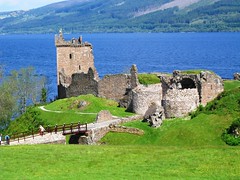Food And Drink
Food & Drink in Scotland
Food in Scotland | Drinking in Scotland
Introduction While Scotland's national drink is loved the world over, Scottish cooking hasn't exactly had a good press over the years. This is perhaps not too surprising, as the national dish, haggis, consists of a stomach stuffed with diced innards and served with mashed tatties (potatoes) and neeps (turnips). Not a great start. And things got even worse when the Scots discovered the notorious deep-fried Mars bar.
But Scottish cuisine has undergone a dramatic transformation in recent years and Scotland now boasts some of the most talented chefs, creating some of the best food in Britain.
The heart of Scottish cooking is local produce, which includes the finest fish, shellfish, game, lamb, beef and vegetables, and a vast selection of traditionally made cheeses.
What makes Scottish cooking so special is ready access to these foods. What could be better than enjoying an aperitif whilst watching your dinner being delivered by a local fisherman, knowing that an hour later you'll be enjoying the most delicious seafood?
Modern Scottish cuisine is now a feature of many of the top restaurants in the country. This generally means the use of local ingredients with foreign-influenced culinary styles, in particular French.
International cuisine is also now a major feature on menus all over the country, influenced by the rise of Indian and Chinese restaurants in recent decades. Indeed, so prevalent are exotic Asian and Oriental flavours that curry has now replaced fish and chips (fish supper) as the nation's favourite food.
Anyone staying at a hotel, guesthouse or B&B will experience the hearty Scottish breakfast, which includes bacon, egg, sausage and black pudding (a type of sausage made with blood), all washed down with copious quantities of tea, Scotland's staple drink.
Although coffee is readily available everywhere, do not expect cappuccinos and café lattes: filter coffee is the staple 'tea-substitue' in most hotels and B&Bs. You may also be served kippers (smoked herring) or porridge, an erstwhile Scottish staple, which is now eaten by few people. Porridge is made with oatmeal and has the consistency of Italian polenta. It is traditionally eaten with salt, though heretics are offered sugar instead.
Oatcakes (oatmeal biscuits) may also be on offer, as well as potato scones, baps (bread rolls), bannocks (a sort of large oatcake) or butteries (butter-laden bread similar to a croissant). These local baked goodies can be spread with marmalade, brought to the world's breakfast tables by the city of Dundee.
After such a huge cooked breakfast you probably won't feel like eating again until dinner, or tea, taken between 1700 and 1800, and a national institution consisting of a cooked main course (usually fish and chips) and a smorgesbord of scones and cakes, washed down with more pots of tea.
Eating categories Places to eat are divided into three categories: expensive (over £20 a head); mid-range (£10-20 a head); and cheap (under £10 a head). These prices are based on a two-course meal (main course plus starter or dessert) without drinks. We have tried to include an equal number of choices in each category, though this is not always possible. All places listed are recommended as offering relatively good value, quality and standards of service within their respective price category.
Scottish dishes Fish, meat and game form the base of many of the country's finest dishes. Scottish beef, particularly Aberdeen Angus, is the most famous in the world and has escaped the worst of the recent BSE scares. This will, or should, usually be hung for at least four weeks and sliced thick.
Game is also a regular feature of Scottish menus, though it can be expensive (dear), especially venison (deer), but delicious and low in cholesterol. Pheasant and hare are also tasty, but grouse is, quite frankly, overrated.
Fish and seafood are fresh and plentiful, and if you're travelling around the northwest coast you must not miss the chance to savour local mussels, prawns, oysters, scallops, langoustines, lobster or crab.
Salmon is, of course, the most famous of Scottish fish, but you're more likely to be served the fish-farmed variety than 'wild' salmon, which has a more delicate flavour. Trout is also farmed extensively, but the standard of both remains high. Kippers are also a favourite delicacy, the best of which come from Loch Fyne or the Achiltibuie smokery. Arbroath smokies (smoked haddock) are a tasty alternative.
Haggis has made something of a comeback, and small portions are often served as starters in fashionable restaurants. Haggis is traditionally eaten on Burns Night (25 January) in celebration of the great poet's birthday, when it is piped to the table and then slashed open with a sword at the end of a recital of Robert Burns' 'Address to the Haggis'.
Other national favourites feature names to relish: cock-a-leekie is a soup made from chicken, leeks and prunes; cullen skink (my own favourite) is a delicious concoction of smoked haddock and potatoes; while at the other end of the scale of appeal is hugga-muggie, a Shetland dish using fish's stomach. There's also the delightfully named crappit heids (haddock heads stuffed with lobster) and partan bree (a soup made form giant crab's claws, cooked with rice). Rather more mundane is the ubiquitous Scotch broth, made with mutton stock, vegetables, barley, lentils and split peas, and stovies, which is a mash of potato, onion and minced beef.
Waist-expanding puddings or desserts are a very important part of Scottish cooking and often smothered in butterscotch sauce or syrup in order to satisfy a sweet-toothed nation. There is a huge variety, including cranachan, a mouth- watering mix of toasted oatmeal steeped in whisky, cream and fresh raspberries, and Atholl Brose, a similar confection of oatmeal, whisky and cream.
Eaten before pudding, in the French style, or afterwards, are Scotland's many home-produced cheeses, which have made a successful comeback in the face of mass-produced varieties. Amongst the tastiest examples are Lanark Blue, made from unpasteurized ewe's milk and similar to Roquefort, and Teviotdale and Bonchester, which both come from the Borders. Many of the finest cheeses are produced on the islands, especially Arran, Mull, Islay and Orkney. Caboc is a creamy soft cheese rolled in oatmeal and is made in the Highlands.
Where to eat There are places to suit every taste and budget. In Edinburgh and Glasgow in particular you'll find a vast selection of eating places, including Indian, Chinese, Italian and French restaurants, as well as Thai, Japanese, Mexican, Spanish and, of course Scottish.
More and more restaurants, however, are moving away from national culinary boundaries and offering a wide range of international dishes and flavours, so you'll often find Latin American, Oriental and Pacific Rim dishes all on the same menu. This is particularly the case in the many continental-style bistros, brasseries and café-bars, which now offer a more informal alternative to traditional restaurants.
It is becoming increasingly irrelevant to talk of a particular nationality of cooking, and for this reason places to eat in this guide are grouped according to price and location instead.
Not surprisingly, other parts of Scotland do not offer the same choice as Edinburgh and Glasgow, two cities with the greatest selection of places to eat in the UK outside London.
Vegetarians are increasingly well catered for, especially in the large cities, where exclusively vegetarian/vegan restaurants and cafés are often the cheapest places to eat. Outside the cities, vegetarian restaurants are thin on the ground, though better-quality eating places will normally offer a reasonable vegetarian selection.
For a cheap meal, you're best bet is a pub, hotel bar or café, where you can have a one-course meal for around £5 or less, though don't expect gourmet food. The best value is often at lunch time, when many restaurants offer three-course set lunches or business lunches for less than £10.
You'll need a pretty huge appetite to feel like eating a three-course lunch after your gigantic cooked breakfast, however.
Also good value are the pre-theatre dinners offered by many restaurants in the larger towns and cities (you don't need to have a theatre ticket to take advantage). These are usually available from around 1730-1800 till 1900-1930, so you could get away with just a sandwich for lunch.
The biggest problem with eating out in Scotland, as in the rest of the UK, is the ludicrously limited serving hours in most pubs and hotels. These places only serve food between 1230 and 1400 and 1700 and 1900, seemingly ignorant of the eating habits of foreign visitors, or those who would prefer a bit more flexibility during their holiday.
In small places especially it can be difficult finding food outside these strictly enforced times. Places which serve food all day till 2100 or later are restaurants, fast-food outlets and the many chic bistros and café-bars, which can be found not only in the main cities but increasingly in smaller towns. The latter often offer very good value and above-average quality.
Those who prefer to eat to live, rather than the other way round, need never spend more than £5-6 for lunch and £7-10 for dinner, excluding drinks. It is generally not difficult to find a cheap meal, though on many of the islands and in parts of the northwest Highlands, there is less choice and prices tend to be higher.
Also, if you're on a tight budget avoid those restaurants at visitor centres or other such tourist traps, as they tend to charge exorbitant prices for very average food. At the other end of the scale, there are many excellent restaurants. Outside Edinburgh and Glasgow, these are often found in hotels, where you can enjoy the finest of Scottish cuisine, often with a continental influence. You can expect to pay from around £25 a head up to £40 or £50 in the very top establishments.
















